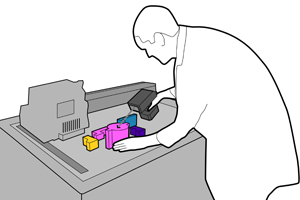Press Release: Carnegie Mellon, Microsoft Researchers Demonstrate Internal Tagging Technique for 3D-Printed Objects
Terahertz Imaging Could Read Information Encoded Inside Objects
Contact: Byron Spice / 412-268-9068 / bspice@cs.cmu.edu
 PITTSBURGH—The age of 3D printing, when every object so created can be personalized, will increase the need for tags to keep track of everything. Happily, the same 3D printing process used to produce an object can simultaneously generate an internal, invisible tag, say scientists at Carnegie Mellon University and Microsoft Research.
PITTSBURGH—The age of 3D printing, when every object so created can be personalized, will increase the need for tags to keep track of everything. Happily, the same 3D printing process used to produce an object can simultaneously generate an internal, invisible tag, say scientists at Carnegie Mellon University and Microsoft Research.
These internal tags, which the researchers have dubbed InfraStructs, can be read with an imaging system using terahertz (THz) radiation, which can safely penetrate many common materials. In proof-of-concept experiments, Karl Willis, a recent Ph.D. graduate in computational design at Carnegie Mellon, and Andy Wilson, a principal researcher at Microsoft Research, have demonstrated several possible tag designs and the THz imaging and data processing steps necessary to read them.
The tags themselves come at no extra cost, Willis said, but THz imaging, still in its infancy, can be pricey. As this imaging technology matures and becomes more affordable, however, InfraStructs could be used for a number of applications beyond keeping track of inventory or making point-of-sale transactions.
For instance, they could help mobile robots recognize or differentiate between things. They might encode information into custom accessories used in game systems. Or, they might enable new tabletop computing scenarios in which objects can be sensed regardless of whether they are stacked, buried or inserted inside other objects.
Willis and Wilson will present their findings July 25 at SIGGRAPH 2013, the International Conference on Computer Graphics and Interactive Techniques, in Anaheim, Calif.
Unlike conventional manufacturing, every single thing produced with digital fabrication techniques, such as 3D printing and laser cutting, can differ from the next, even in subtle ways. "You probably don't want to have visible barcodes or QR codes on every object you make," Willis said. Inserting a radio frequency identification (RFID) tag into each component would be a possibility, he acknowledged, but for now that would require interrupting the normal 3D printing process.
InfraStructs, by contrast, can be made with the same layer-by-layer process used for producing the object. In some cases, information can be encoded by positioning bubbles or voids inside the object; those voids reflect THz radiation. In other cases, materials that are reflective of THz radiation might be used to encode the information or create images inside the object.
"The ability to embed 3D patterns gives designers new opportunities in creating objects that are meant to be sensed and tracked," Wilson said. "One idea is to embed a code just under the surface of the object, so that a THz beam can recover its position on the surface, wherever it strikes the object."
THz radiation falls between microwaves and infrared light on the electromagnetic spectrum. It can penetrate many common plastics, papers and textiles but, unlike X-rays, does not harm biological tissues. THz imaging has yet to be fully commercialized. NASA famously has used it for inspecting the protective tiles on the space shuttle, detecting the same sort of voids Willis and Wilson have now used to encode information with InfraStructs.
Willis' work on InfraStructs occurred while he was an intern at Microsoft Research. Additional research on materials, fabrication processes and imaging techniques will be necessary if the tags are to be widely adopted. InfraStructs aim to take advantage of trends toward high-speed electronics at THz frequencies and the rapidly growing capabilities of digital fabrication.
For more information, visit the project website at http://www.karlddwillis.com/projects/infrastructs/ or the Microsoft Research Blog.
###
InfraStructs can be made with the same layer-by-layer process used for producing the object. In some cases, information can be encoded by positioning bubbles or voids inside the object; those voids reflect THz radiation. In other cases, materials that are reflective of THz radiation might be used to encode the information or create images inside the object.